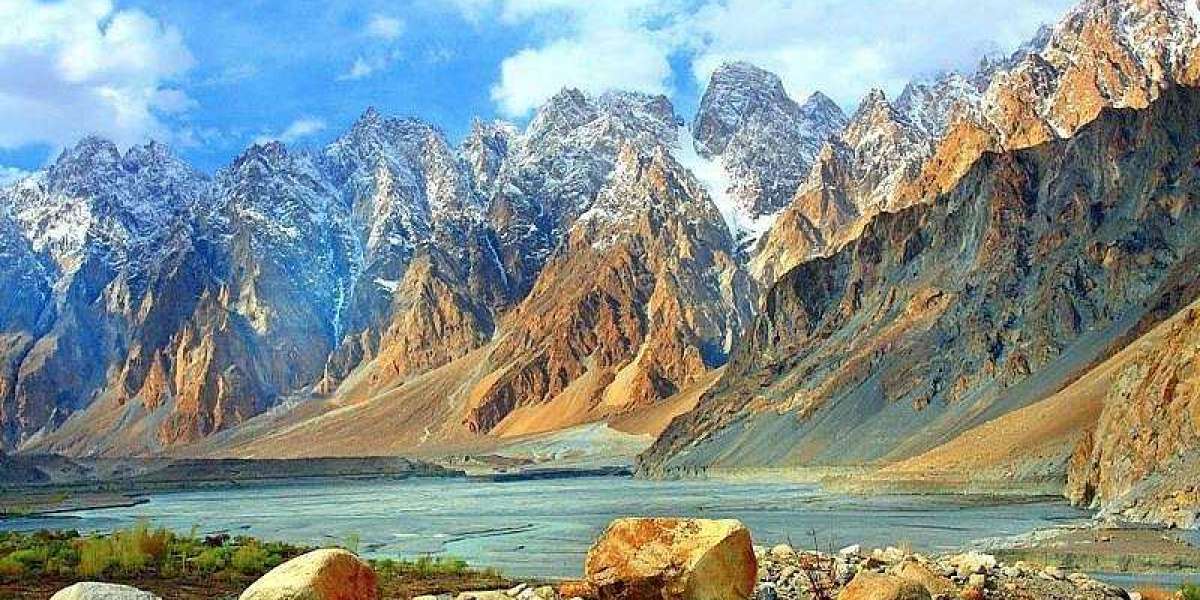Tucked away in the far north of Pakistan, where the Himalayas, Karakoram, and Hindu Kush mountain ranges converge, lies a valley so stunning it feels otherworldly. The Hunza Valley, often called “Heaven on Earth,” is cradled by towering peaks like Rakaposhi, Ultar Sar, and Ladyfinger Peak—some of the mightiest mountains on the planet. Here, in the shadow of these giants, life unfolds at a rhythm both timeless and humbling. This is a place where nature commands reverence, and the human spirit adapts and thrives.
A Land of Timeless Beauty
The landscape of the Hunza Valley is a striking canvas of contrasts—snow-capped peaks rising over 7,000 meters above sea level, emerald terraced fields clinging to the hillsides, and turquoise rivers meandering through rocky canyons. At dawn, the mountains catch the first golden rays of sunlight, igniting a fiery glow that reflects off the icy summits and dances across the valley floor. The sheer scale of the geography inspires awe. Standing in Hunza, one is constantly reminded of how small humans are in the face of such grandeur—and yet, how persistent and resilient they can be.
The valley is dotted with small, traditional villages like Karimabad, Passu, Gulmit, and Ganish—each with its own distinct flavor but united by a deep connection to the land. The traditional stone homes, often built into the slopes, are designed to withstand the harsh winters and the occasional tremors that ripple through this seismically active region.
A Culture Carved by Mountains
Life beneath the Hunza peaks is shaped by both isolation and ingenuity. For centuries, the valley was largely cut off from the rest of the world, accessible only by narrow trails snaking through treacherous mountain passes. This geographic isolation fostered a self-reliant culture deeply in tune with the environment.
The people of Hunza are known for their warmth, hospitality, and a unique cultural heritage that blends influences from Central Asia, Persia, and Tibet. Many residents are Wakhi or Burusho, each with their own language, customs, and traditions. The Burushaski language, in particular, is a linguistic isolate—unrelated to any other language on Earth—testifying to the valley’s long-standing seclusion.
Music and dance play a vital role in Hunza culture. During local festivals, the valley comes alive with colorful attire, rhythmic drumming, and traditional dances that celebrate the seasons, the harvest, and life itself. These moments are a joyful reminder that even in the remotest corners of the world, the human spirit finds ways to express itself.
Agriculture in a Vertical World
In Hunza, farming is an act of perseverance. With limited arable land and a vertical terrain, locals have developed an ingenious system of terraced agriculture. These narrow strips of cultivated land climb the mountainsides like staircases, fed by an intricate network of irrigation channels known as kuls, which divert glacial meltwater to the fields.
Apricots are a symbol of the valley’s agricultural success and are found in abundance during the summer. They are eaten fresh, sun-dried, or pressed into oil. Hunza apricot oil is believed to have healing properties and is used in cooking, skincare, and medicine. Other key crops include wheat, barley, potatoes, and various fruits and nuts.
Despite the challenges, agriculture not only sustains families but fosters a deep connection to the land. Every seed sown is a quiet act of defiance against the harshness of the terrain—a testament to human determination in the face of nature’s extremes.
A Legacy of Longevity
Hunza is often associated with the myth of extraordinary longevity. Tales of residents living past 100 years have attracted researchers and health enthusiasts from around the globe. While some of the claims may be exaggerated, there is no denying that the Hunza lifestyle contributes to remarkable health and vitality.
A diet rich in natural, organic foods, clean glacial water, daily physical activity, and low stress levels all play a part. But it’s more than just biology—it's a holistic way of life. Community bonds are strong, families are close-knit, and there is a deep sense of purpose rooted in tradition and faith. The people of Hunza follow a form of Islam known as Ismailism, which emphasizes education, pluralism, and spiritual development, all of which shape the social and intellectual fabric of the valley.
Changing Times and New Challenges
Modernity has begun to creep into the valley, brought in part by the Karakoram Highway—the legendary road that connects Pakistan to China. This engineering marvel has opened up Hunza to tourism, trade, and education, bringing new opportunities but also new challenges.
Tourism has become a major economic driver, with travelers from around the world drawn to the area’s natural beauty and cultural richness. Guesthouses, cafés, and trekking agencies have popped up across the valley. While this has boosted income for many locals, it has also strained resources and begun to alter the valley’s traditional way of life.
Climate change poses an even more existential threat. The glaciers that feed Hunza’s rivers are retreating, and erratic weather patterns are becoming more common. Glacial lake outburst floods (GLOFs), landslides, and changing rainfall patterns threaten homes, crops, and infrastructure. Local communities, along with NGOs and the government, are working to adapt through disaster preparedness programs and sustainable development initiatives—but the road ahead is uncertain.
Holding On to Heritage
Despite the changes, the people of Hunza remain fiercely proud of their heritage. Local schools now offer instruction in native languages, cultural festivals are celebrated with renewed vigor, and there is a growing emphasis on sustainable tourism that respects the environment and local customs.
Young people in the valley are increasingly bridging the gap between tradition and innovation. Many pursue higher education in cities but return to contribute to their communities—starting eco-friendly businesses, promoting heritage crafts, or working in education and healthcare.
In many ways, Hunza stands as a living example of how communities can adapt while staying rooted in who they are. It is a reminder that progress doesn’t have to mean erasure, and that living in harmony with the land is still possible—even in the 21st century.
Conclusion: Life Among Giants
To live in Hunza is to live with giants—both literal and metaphorical. The mountains inspire not just awe, but a deep sense of humility and respect. Life here is shaped by both the grandeur and the challenges of the landscape. It is a life of resilience, balance, and grace.
As the world continues to change, Hunza offers lessons for us all—about endurance, simplicity, and the power of community. Beneath the towering peaks, in a valley carved by time and tenacity, life continues—quiet, strong, and deeply human.







